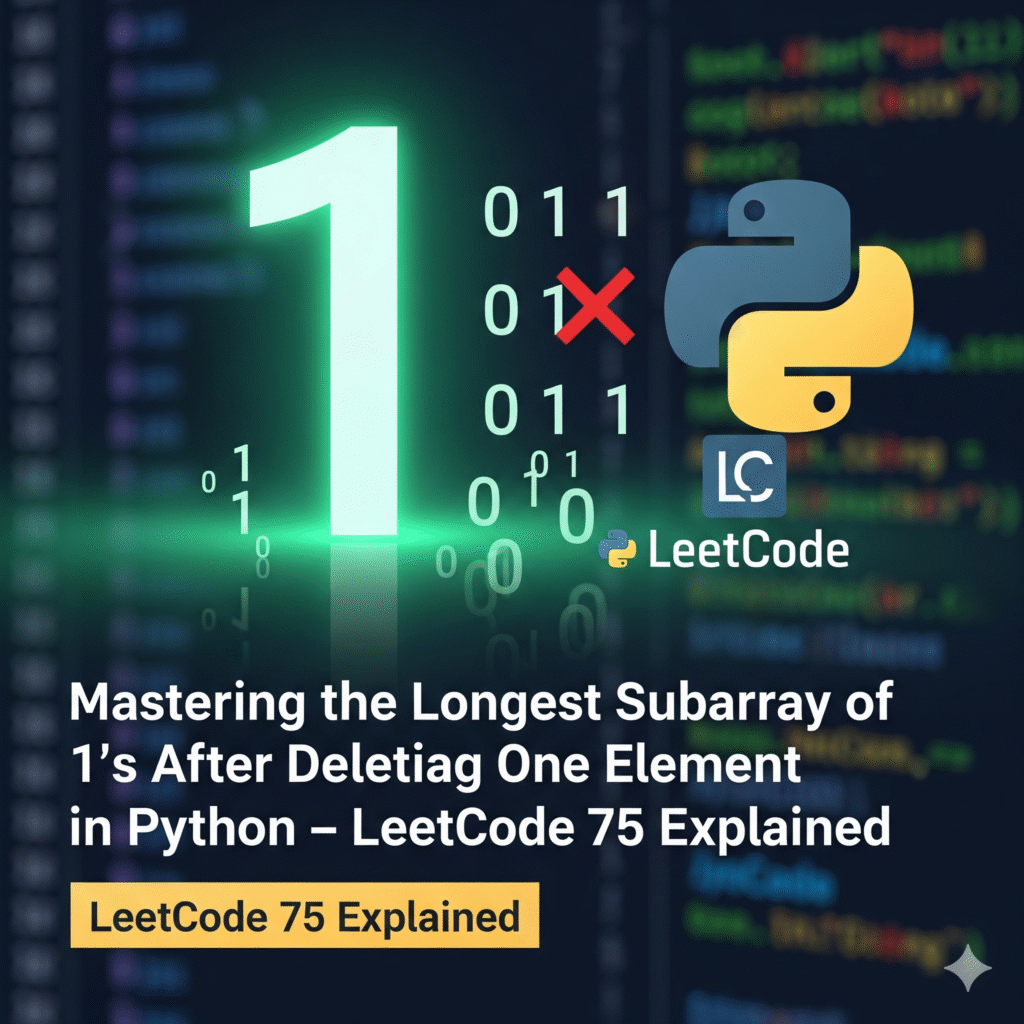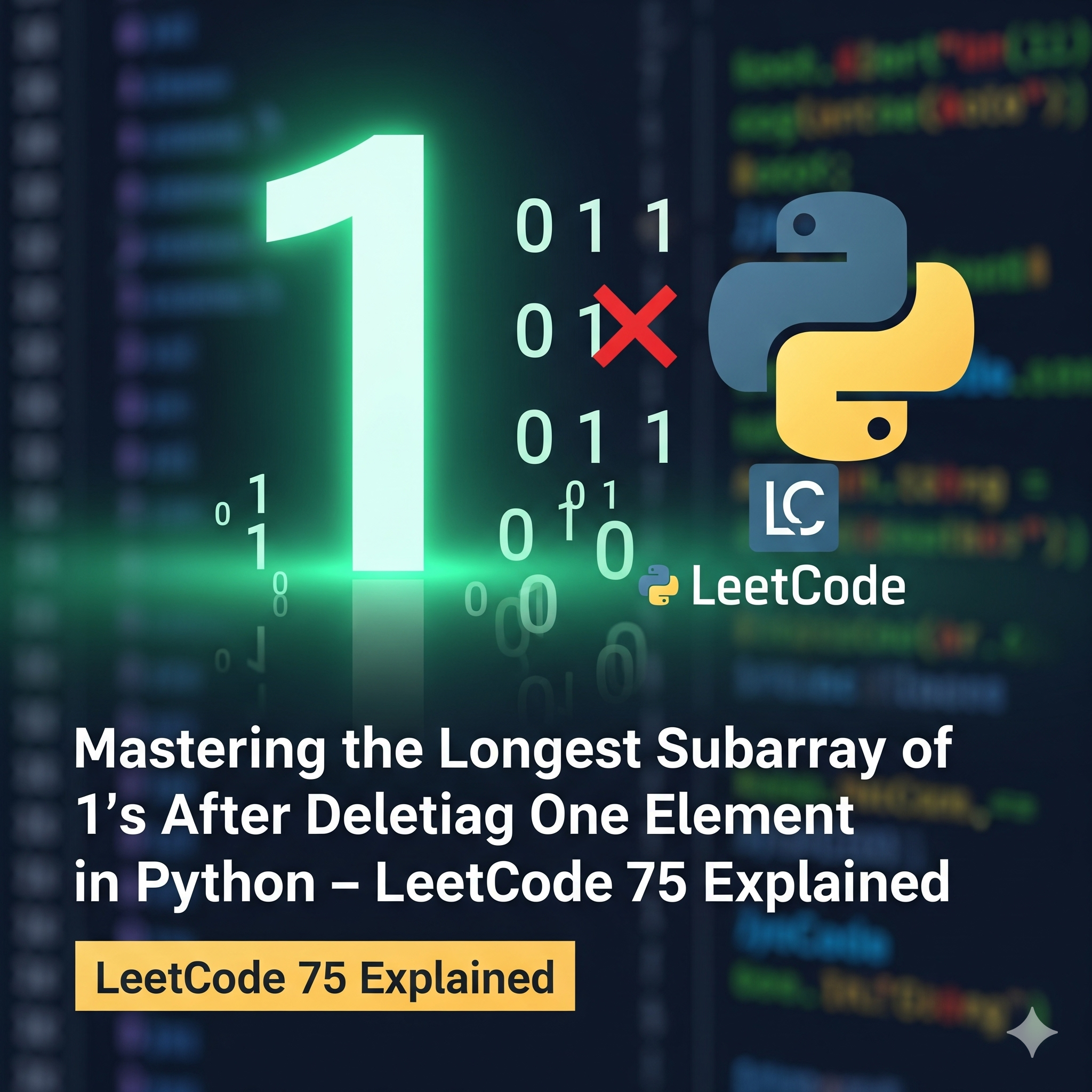The Longest Subarray of 1’s After Deleting One Element problem is a frequently asked interview question that tests your understanding of sliding window techniques and careful handling of constraints. The task is simple but tricky: given a binary array, delete exactly one element and return the length of the longest subarray consisting only of 1s.

In this blog, we’ll break down the problem, explain it step by step, and implement an optimized Python solution using the sliding window method.
Table of Contents
Problem Statement
You are given a binary array nums. You must delete exactly one element from it. Return the size of the longest subarray containing only 1s after deleting one element.
Understanding the Problem
- A subarray is a contiguous slice of the array.
- You must delete one element (can be
0or1). - The challenge is to maximize the count of consecutive
1s after this deletion.
This is very similar to Max Consecutive Ones III but instead of being allowed to flip multiple zeros, here you’re required to remove exactly one element.
Examples
Example 1:
Input: nums = [1,1,0,1]
Output: 3
Explanation: Delete the single zero → longest subarray = [1,1,1]
Example 2:
Input: nums = [0,1,1,1,0,1,1,0,1]
Output: 5
Explanation: Delete the zero at index 4 → longest subarray = [1,1,1,1,1]
Example 3:
Input: nums = [1,1,1]
Output: 2
Explanation: Must delete one element → longest subarray = length 2
Python Solution – Step-by-Step Explanation
from typing import List
class Solution:
def longestSubarray(self, nums: List[int]) -> int:
res, l, prefix = 0, 0, 0
for r, n in enumerate(nums):
prefix += n
# shrink window if more than one zero inside
while prefix < r - l:
prefix -= nums[l]
l += 1
res = max(res, r - l) # r - l ensures one deletion
return res
Step 1: Track counts with sliding window
for r, n in enumerate(nums):
prefix += n
- Iterate over array with
ras right pointer. prefixtracks the number of ones in the current window.
Step 2: Handle constraint of one deletion
while prefix < r - l:
prefix -= nums[l]
l += 1
- If the number of zeros in the window exceeds 1, shrink the window from the left.
- We ensure at most one deletion allowed.
Step 3: Update maximum length
res = max(res, r - l)
- Window length =
(r - l)not(r - l + 1)because we must delete one element.
Step 4: Return result
return res
- Returns the maximum subarray length of consecutive ones after one deletion.
Why This Solution Works
- The window
[l..r]always maintains the constraint: at most one zero inside. r - lcorrectly reflects the longest subarray length after deleting one element.- Efficiently handles large arrays with a single pass.
Time and Space Complexity
| Metric | Value |
|---|---|
| Time Complexity | O(n) – each element processed once |
| Space Complexity | O(1) – only pointers and counters |
Edge Cases to Consider
| Input | Output | Explanation |
|---|---|---|
| [1,1,1] | 2 | Must delete one element even if all are ones |
| [0,0,0] | 0 | Deleting one zero still leaves only zeros |
| [1,0,1,1,0,1] | 3 | Best subarray after one deletion is length 3 |
Real-World Applications
- Data transmission: Find longest streak of successful signals after dropping one bad packet.
- Quality control: Maximize consecutive non-defective products after removing one faulty unit.
- Network reliability: Longest uptime sequence after ignoring one downtime.
Conclusion
The Longest Subarray of 1’s After Deleting One Element is a textbook sliding window problem. By maintaining a valid window with at most one zero and tracking its maximum size, we achieve a clean and efficient O(n) solution.
Mastering this problem sharpens your ability to apply window adjustment techniques to interview problems where one constraint must always be enforced.
Related Reads
- Mastering the Max Consecutive Ones III Problem in Python – LeetCode 75 Explained
- AIPython & Online Learning Resources for Artificial Intelligence: Foundations of Computational Agents (3rd Edition)
- Agentic Design Patterns – A Hands-On Guide to Building Intelligent Systems by Google’s Antonio Gulli
- ART: Agent Reinforcement Trainer – Simplifying Reinforcement Learning for LLMs
- PySpark Cheatsheet: The Ultimate Quick Reference for Big Data & Machine Learning
References
LeetCode – Longest Subarray of 1’s After Deleting One Element


4 thoughts on “Mastering the Longest Subarray of 1’s After Deleting One Element in Python – LeetCode 75 Explained”